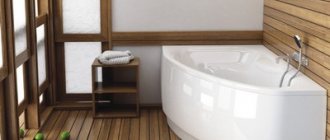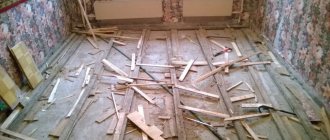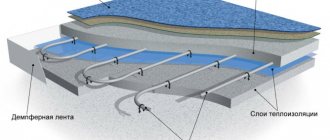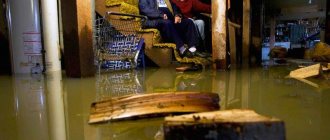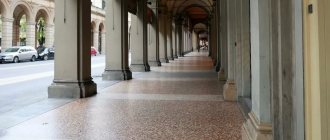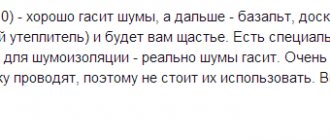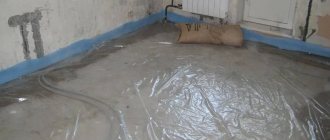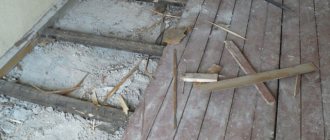Bitumen-polymer mastic, the so-called liquid rubber, is a universal material that is used as insulation of surfaces from the penetration of water, vapor and sound insulation. To install the finished floor, hard coatings made of cast or pressed rubber and self-leveling compounds are used. Resistance to destructive processes occurring under the influence of temperature changes allows the use of rubber coating indoors and outdoors. They equip sports fields and park paths, floors in garages and industrial buildings.
Rubber flooring - advantages and disadvantages
For the construction of rubber coatings, various materials are made, differing in appearance and structure, but they are united by a number of useful advantages:
- durability, strength, abrasion resistance;
- resistance to chemicals;
- waterproof, soundproof effect;
- icing resistance, anti-slip properties;
- shock-absorbing effect, environmental safety;
- aesthetics, ease of installation, ease of cleaning.
With many advantages, monolithic rubber floor coverings have only one drawback - they are quite difficult to repair in the event of gross defects - cuts, tears.
Review of materials for rubber floor coverings
Modern industry produces liquid polymer-bitumen materials that are used to perform insulation or create self-leveling floors. On sale on the construction market there are also ready-made coatings made from cast rubber or obtained by pressing rubber crumbs, a product of processing used car tires.
- Liquid rubber . A material, various modifications of which are used for waterproofing surfaces and self-leveling floors. One-component bitumen mastics with the inclusion of polymer elements are completely ready for application to the prepared base. If the technology is followed, liquid waterproofing creates an airtight film on the surface, impenetrable to moisture and steam. To make self-leveling floors, mixtures consisting of polyurethane, chips and dyes are usually used. As a result of pouring, a seamless decorative coating is obtained that has excellent performance characteristics.
- Modular tiles . Sector rubber elements consist of shredded tires, glue, modifiers and dyes, and are pressed into slabs of various sizes and thicknesses. They are used for covering sports fields, car garages, and industrial premises. Modular tiles are equipped with a locking system, so they are easy to assemble, like a children's construction set. Defective elements can be easily replaced with new ones if necessary. You can read more about this material here.
- Roll coverings . Rubber linoleum or relin is a two-layer material consisting of rubber and natural rubber. The relief surface gives relin excellent anti-slip properties. Rubber linoleum is laid in industrial and public premises, in gyms, and in open areas. It is indispensable in conditions of high humidity and is resistant to aggressive chemicals. Street paths made of cast rubber are not prone to icing, and the textured surface prevents slipping.
Types of rubber floor coverings
Today, manufacturers offer different types of rubber flooring.
Tile covering
The material is produced from recycled car tires, crushed to a fraction of 0.1...10 mm. The most common type of binder is a polyurethane-based adhesive composition. To make the cladding aesthetically pleasing, various dyes (pigments of different colors) are used. The choice of the size module of the main raw material depends on the purpose of the tile. For lining children's play areas, garages or industrial workshops, crumbs with a fraction of no more than 1 mm are usually used (this material has a smoother surface); for the installation of treadmills, it is recommended to use granules measuring 2...4 mm.
Rubber tiles
The tiles can be single-layer, but most often for flooring they choose an option where a second layer (painted) of a smaller product is applied to a base substrate made from coarse chips.
The density of rubber tiles can vary from 850 to 1000 kg/m3. The thickness of the cladding offered by manufacturers is 10…100 mm. This parameter is selected based on the purpose of the object where the coating is laid. For finishing work in auto repair shops, a material with a thickness of 2 to 4 cm is suitable. It is better to cover the floor of a sports room with tiles with a thickness of 4 to 5 cm. To fix the covering elements to each other, various locking systems are used.
Rubber tiles “Module”
Coating is carried out using vibrocasting or vibrocompression. It can be installed both indoors and outdoors. The material is characterized by strength, elasticity, safety, long service life (at least 30 years), and immunity to external influences.
What is good about rubber tiles when used as cladding for floors that are not covered by a roof: moisture from its porous surface quickly evaporates, and fallen snow can be easily removed. As a result, neither ice nor snow crust forms on the surface.
Eco Farm for livestock complexes
Roll material
When installing coatings on commercial, industrial, private and sports facilities, rubber roll cladding is ideal.
Rolled flooring
The material is produced by vulcanizing a mixture (hot or cold), the basis of which is granulated rubber obtained from recycling old tires. The required thickness of the lining is achieved by rolling the material (after the sintering process is completed) between rollers. To improve performance characteristics, rubber (most often synthetic) is added to the mass. The inclusion of these granules in the composition allows you to increase the strength parameters, elasticity and resilience of the finished product. Polyurethane glue acts as a binding component; pigments are used to color the material in the required color.
Parameters of roll rubber coatings offered by manufacturers:
- thickness: 0.4…2 cm;
- width: 100…200 cm;
- length: 1500…2000 cm.
This coating can have different sizes
Depending on the task that the material must perform, the technological regulations for its production may vary. The use of various additives and processes can add additional properties to the rubber lining.
- If the coating requires high resistance to static and dynamic loads (most often this is necessary when installing floors in sports facilities and industrial premises), the material is produced in two layers. The first layer (substrate) has high shock-absorbing properties. The second layer, the facing layer, has increased resistance to stress.
- In the production of mats laid in fitness centers, the main emphasis is on ensuring the necessary elasticity and resilience of the floor.
Laying rolled rubber coating
- For industrial and warehouse premises, coatings with increased strength, insulating (vibration and sound) ability, slip resistance, and inertness to aggressive environments are produced.
- When designing entrance groups, the main attention is paid to aesthetics, wear resistance and injury safety. Such a roll covering must be non-slip, elastic and colored.
- Rubber roll materials are also popular, used as temporary flooring to protect expensive cladding. This need often arises during public events.
Covering for sports fields
Self-leveling floor
The great advantage of liquid rubber coatings is the ability to create a seamless base with high performance parameters.
Laying liquid rubber flooring
Rubber flooring is produced from crushed rubber (crumbs), epoxy or polyurethane based adhesive, which is responsible for the integrity of the coating after polymerization, pigments and modifying additives necessary to ensure certain characteristics.
Properties of self-leveling rubber floors:
- elasticity;
- excellent shock absorption capabilities;
- elasticity;
- resistance to mechanical stress, wear and abrasion;
- low risk of injury;
- attractive appearance, absence of seams (even when installing a large floor area);
- combustion resistance.
Self-leveling rubber floor
In addition to all of the above, self-leveling floors are distinguished by the absence of shrinkage after installation, good sound absorption and the possibility of quick restoration in case of damage to any area.
Areas of application for seamless coating: auto repair shops, warehouses, parking lots and garages, gyms and playgrounds.
Self-leveling rubber floor
Rubber floors are offered to the consumer in the form of ready-to-use mixtures or individual components, from which you must independently, in accordance with the proportions proposed by the manufacturer, mix the mixture for the coating.
Prices for rubber tiles Newmix
Rubber tiles Newmix
Popular questions:
Which expanded clay is better for the floor, which fraction to choose? There is an answer from an expert
Which floor is better, concrete or wood? There is an answer from an expert
Which floor is better to make in the garage, which option is cheaper There is an answer from an expert
All questions
Assortment of materials for creating rubber floors
After deciding to install a rubber floor in your garage like the one in the photo, you need to decide on the material from which it will be made.
READ MORE: Review of Kaindl laminate: advantages and disadvantages of coating
The following types of coatings are available for sale:
- rolled rubber products;
- rubber mats,
- tiles (can be embossed or flat modular);
- liquid rubber.
Each rubber floor covering is different:
- according to laying technology;
- by method of operation;
- by cost.
Liquid rubber flooring technology
Rubberized self-leveling floors are installed using various methods. The choice of method depends on the area to be covered and the composition of the mixture. The following methods are distinguished:
- Manual method. The prepared mixture is poured onto the prepared surface. The mixture is leveled with a special tool. Stir the mixture using a construction mixer or an electric drill with a special attachment.
Attention! The quality and durability of the coating depends on how the mixture is prepared. It is necessary to mix the mixture thoroughly so that the coating lasts at least 10-12 years. This method is used for small spaces.
- Automated method. The mixture is prepared and poured using a special machine. A special feature of the equipment is that it controls the thickness of the self-leveling floor and is intended for installation of large areas. Used in stadiums and sports fields. To prepare the mixture, place the components in a special container, where the machine will stir the solution to the optimal consistency.
Machine for preparing a mixture of crumb rubber
- The combined method is designed to create several layers of self-leveling floor. For example: if decorative installation is carried out in several layers, then the first layer is applied using a machine. Then comes the decorative layer, which is covered with a protective top layer, but using a manual method.
- Spraying. Used for arranging rough surfaces of car parks or warehouses. The mixture is applied using a special sprayer under pressure. Convenient due to the speed of application, but uniform coverage is not guaranteed.
Let's take a closer look at how to make a rubber self-leveling floor using the manual method. The method is intended for arranging floors in residential premises.
Laying is done on top of any base: wood, asphalt or concrete.
After the components are prepared, installation of the seamless rubber coating begins. The process goes like this:
- Surface preparation. The concrete surface is leveled, potholes and other defects are repaired. If the surface is metal, then remove rust and oil traces that will interfere with the adhesion of the composition.
- After degreasing, prime the base with polyurethane-based glue, covering the pores.
- If necessary, temporary beacons are installed.
- The solution is prepared as follows: for 1 liter of glue you need 7 liters of crumb rubber. The mass is mixed until smooth with a mixer.
- Apply rubber self-leveling flooring at least 1 cm thick and level with a spatula.
- Roll with a roller, but do not press too hard so as not to cause potholes in the rubber surface. Otherwise, this will negatively affect the technical characteristics of the coating: the dense coating will crack in the cold.
Manual installation
After completing installation, wait 12 hours before putting the room into operation. This method is suitable for covering small spaces with crumb rubber. If the room is large, then filling it manually is problematic.
How to install a non-slip rubber crumb coating on the vestibule stairs in the entrance of a house.
Source
Scope of application of self-leveling rubber floors
Rubber self-leveling flooring forms a soft and durable elastic surface. It is difficult to find a use for it: it is used in a narrow field. The main area of application is children's playgrounds, where a soft surface is important to reduce the risk of injury.
The softness and shock-absorbing qualities of the coating directly depend on the thickness. The greater the thickness, the better it absorbs and softens the fall. For adult sports fields, a thinner self-leveling coating made of crumb rubber is used, which does not provide sufficient softness, but the coating is non-slip, which is important for sports games. Such coverings are used in underground parking lots and stairwells for safe movement through building levels.
Ceramic tile
This flooring is the optimal choice for rooms with high humidity and traffic. Therefore, tiles are often installed in bathrooms, kitchens and hallways. But it can be used in any other room, as well as when installing a “warm floor” system. The main advantages of ceramic tiles include:
- excellent wear resistance;
- resistance to stains and ease of maintenance;
- environmental cleanliness;
- non-flammability;
- resistance to moisture;
- large selection of textures, colors and sizes;
- affordable price.
READ MORE: Linoleum in the interior (50 photos): design ideas for an apartment, how to match the color to the wallpaper in the living room, color options for bleached oak and wenge
In addition, ceramic tiles do not require a perfectly flat surface for installation and excellently protect the base of the floor from the effects of various acids and alkalis. The main disadvantages of such floor coverings are the hardness, fragility and cold surface of the ceramics. It is often used in a “warm floor” system, but practically does not fit in rooms such as a bedroom or children’s room. The tile can also crack if a heavy object is dropped on it.
Liquid self-leveling rubber floor
The rubber floor is moisture resistant, so it is used outdoors. The coloring pigment holds well due to its porous structure. Therefore, the coating is used for sports playgrounds, where the field lines must retain color for a long time.
The composition of the rubber self-leveling floor includes:
- Rubber crumb. The sizes of the fractions are different and form the basis of the material.
- Epoxy or polyurethane based adhesive is a binding element for rubber crumbs.
- Coloring pigments. Used when stirring or added to the mixture at the time of purchase.
- Modifiers. Used to improve specific technical characteristics.
A children's playground covered with self-leveling rubber flooring is a good option for using the material due to its soft structure. It covers closed parking lots and stairwells thanks to the non-slip surface.
There are many ready-made mixtures on the market for installing self-leveling rubber coatings, but you can make them yourself if you purchase the components and use them in the correct proportions.
Among the ready-made mixtures, the following are distinguished:
Price category
The cost of rubber self-leveling flooring depends on many factors. The determining factors are the area of the room and the evenness of the base. To cover one square meter of area, you will need 20 USD. provided that the work is carried out with one's own hands.
